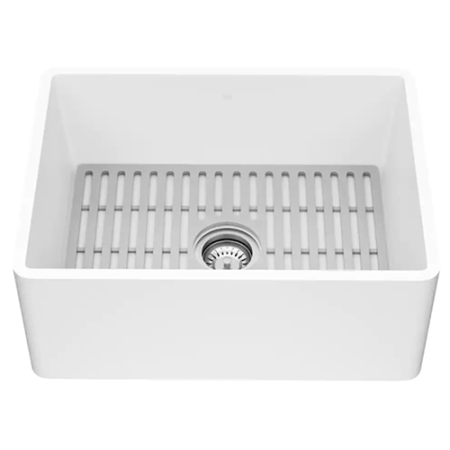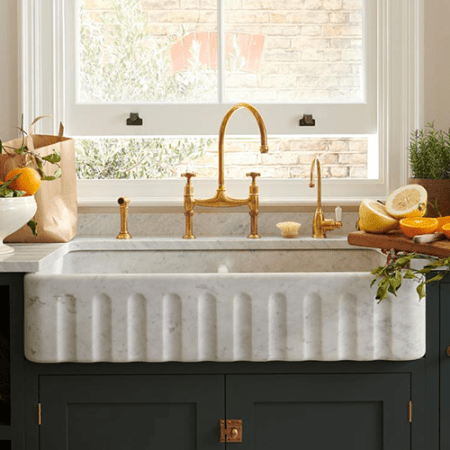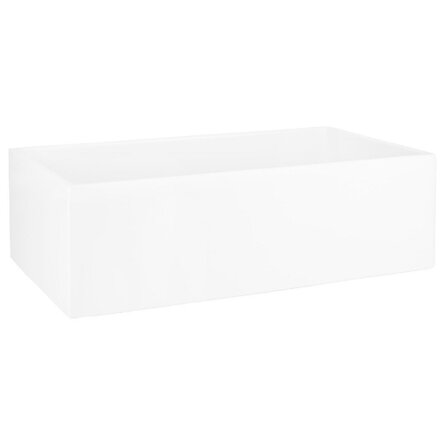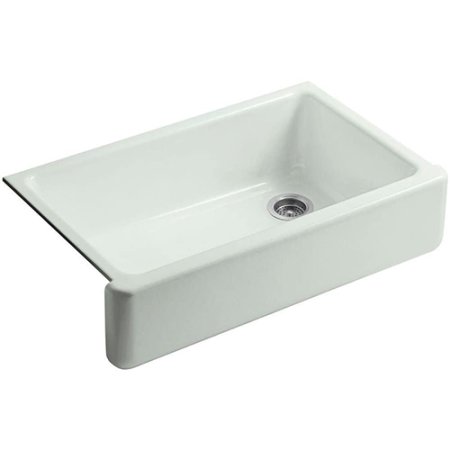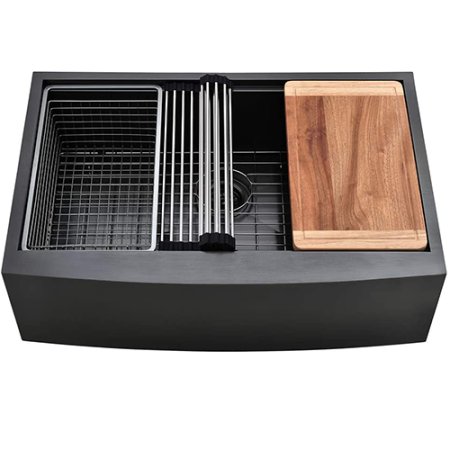We may earn revenue from the products available on this page and participate in affiliate programs.
For a style that has been around since the early 17th century, it’s no surprise that the best farmhouse sinks are timeless. Known for their size, and particularly their depth, these kitchen accessories have been covetable for years; recently, though, the farmhouse sink has evolved into somewhat of a luxury item, despite an origin story that reveals the design was all about practicality. “It made life easier,” explains Helen Parker, creative director of DeVol Kitchens, especially for users who relied on the sink for washing everything from food to dishes to clothes throughout the day.
Given its humble beginnings, it’s easy to silo farmhouse sinks into a single type of interior: We’d wager the first kitchens that come to mind skew traditional or rural, with a cottagey, country vibe. But these sinks aren’t all white porcelain. The best ones are versatile, fitting a range of needs and budgets and coming in all sorts of modern materials, and we found five to prove it.
Our Favorites
- Best concrete: Native Trails Farmhouse Apron Front Slate Sink
- Best composite: Vigo White Composite Stone Farmhouse Sink
- Best marble: DeVol Kitchens Tuscan Farmhouse Marble Sink
- Best large ceramic: Signature Hardware Torun Fireclay Sink
- Best small ceramic: Glacier Bay Farmhouse Sink
Best Concrete: Native Trails Farmhouse Apron Front Slate Sink

Dimensions: 33-by-21-by-9.5 inches | Bowl type: 60/40 double basin | Installation type: Undermount, apron front | Drain requirements: Two, 3.5-inch drain
What we like:
- Matte texture
- Double bowl (great for amateur chefs and frequent hosts)
Worth noting:
- Drains sold separately
Why we chose it: Lighter and stronger than your standard concrete sink.
“Honoring the architecture is always my first priority when designing a space,” says designer Katrina Hernandez, and that includes in her own weekend escape, a 1930s farmhouse. “I chose materials that were elevated but simple,” she adds, including this anything but ordinary concrete sink. The double-bowl style is made from a sustainable mixture infused with jute fibers, which ups the durability (as does an innovative sealer that protects against stains, scratches, and cracks), and also makes it 40 percent lighter compared to typical concrete. Stylewise, Hernandez loves that the sink is a marriage between utilitarian purpose and clean, modern lines. “It is the perfect sink for dish washing after many happy meals, looking out at a picturesque view,” she notes.

Best Composite: Vigo White Composite Stone Farmhouse Sink
Dimensions: 27-by-18-by-9 inches | Bowl type: Single basin | Installation type: Undermount, (reversible) apron front, or flush front | Drain requirements: One, 3.5-inch drain
What we like:
- Matte-stone look
- Included drain system
- Heat-resistant
Worth noting:
- Somewhat small
Why we chose it: A classic silhouette upgraded in an affordable, durable material.
When creative Sarah Lawrence first came across this sink, she thought it was too good to be true. She had seen something almost identical—a ceramic Shaws Original sink—but for double the price, it was just too high to justify, she says. But one of the biggest benefits of composite is the affordable price point—and its resistance to chips and stains. Since installing the sink in her own Colorado cabin, Lawrence has had no problems. “We truly love this sink,” she notes, particularly the simplicity of the single basin. “I knew I wanted a big and open feel and to be able to fit my pots and pans for hand-washing,” she adds. “It has worked like a charm, honestly.” For an extra confidence boost, this particular unit comes with a silicone grid to protect the sink base (and a complimentary cutting board, too).

Best Marble: DeVol Kitchens Tuscan Farmhouse Marble Sink
Dimensions: Varies | Bowl type: Single or double options | Installation type: Undermount, apron front | Drain requirements: Varies
What we like:
- Luxurious elegance
- Bespoke sizes also available
- Made to order; hand-finished
Worth noting:
- Pricey
- Will naturally patina over time
Why we chose it: Get the coveted English cottage kitchen look.
A little bit vintage, a little bit present-day, DeVol’s aesthetic is a nod to the past but acknowledges the necessity of modern functionality, and the brand’s Tuscan farmhouse sink line is the perfect example. It’s perhaps no surprise that Parker used one of the marble farmhouse sinks in her own kitchen. She loves the look for its grandeur: “It instantly transforms the kitchen into a Mediterranean oasis,” she tells Domino. “The color is mottled and softer than white ceramic,” and the organic, swirled veining adds visual intrigue. “It feels somehow less new and more authentic and has an impressive yet very understated look, which really appealed to me,” she adds.

Best Large Ceramic: Signature Hardware Torun Fireclay Sink
Dimensions: 36-by-21-by-8.5 inches | Bowl type: Single basin | Installation type: Undermount, apron front | Drain requirements: One, 3.5-inch drain
What we like:
- Grade-A fireclay
- Offset drain
- Smooth, ripple-resistant surface
Worth noting:
- A regular drain ($79) or garbage disposal ($99) costs extra
Why we chose it: Extra length and depth makes for a roomier sink.
Designer Jamie Haller prefers fireclay for its texture and glazed gleam (and its heat-resistant properties, too). For this 1905 Craftsman kitchen upgrade, she was on the lookout for a farmhouse sink with clean lines and generous depth. “The trick was finding one that suited the look and feel I was going for in my budget and style,” she says. “I wanted a large, deep, single basin, as I have found it offers the most flexibility. I had a double basin before and often felt like I needed more space.” This one was generously sized—and it can even withstand temperatures up to 2,700 degrees. And while Haller went with white, there’s also a matte black option.

Best Small Ceramic: Glacier Bay Farmhouse Sink
Dimensions: 27-by-19-by-10 inches | Bowl type: Single basin | Installation type: Undermount, apron front | Drain requirements: Two, 3.5-inch drain
What we like:
- Deepest of the list
- Under $350
Worth noting:
- Necessary accessories cost extra
Why we chose it: Small but mighty.
Although shorter in length, this fireclay option more than makes up for its petite size with its 10-inch depth; in fact, it’s the deepest on our list. “It’s a great size to easily wash all our pots and pans,” offers Emily Schoen, a real-estate agent who took on most of the renovations in her Michigan English Tudor herself. “We also knew that we’d want to bathe our baby in this sink, and it’s a perfect size for that.” In fact, she and her partner, Alex, didn’t consider any other style for this reason (though being able to easily wipe crumbs off the counter, thanks to the undermount style, was another huge bonus), and the price of this hardware store find was unmatched, fitting into their tight budget no problem.

On Our Radar
How We Chose These Products
We reached out to the homeowners and designers behind a few of our favorite kitchen renovations to see how they sourced the best farmhouse sinks for their space. While style was at the top of each of their must-have lists, other preferences varied, whether it was a unique material or a single basin versus two. Our list offers farmhouse sinks in a range of price points and materials, some available from your local hardware store, others custom-made by high-end, specialty retailers.
Our Shopping Checklist
Sink Types
Essentially, farmhouse sinks come in two different formats: single basin and double basin. If you’re looking to do more than just wash and dry dishware—say, for giving your small pup or babe a bath—then you’ll need a roomier single bowl. With a single basin sink, there are no dividers; it’s wide open. On the other hand, a double basin features a divider that separates it into equal halves or smaller and larger sides, particularly useful for cooking, washing dishes, or sorting dirty from clean pots and pans. With either, you can purchase all sorts of workstation accessories to suit your range of needs, even attachable cutting boards.
Size and Installation
“Farmhouse sinks will fit into tiny cottages or large country house kitchens,” explains Parker. Since the sinks can range from 20 to 60 inches in length, you just have to pick out the right size to fit your space, and that often means factoring in the depth, from the top to the bottom of the front. This is especially important if you’re doing a whole new install, as you’ll have to factor in removing the cupboards below or going with false, sink-specific cabinet drawers. According to Home Depot’s guide, you’ll need to subtract about an inch of the space between the top of the counter and cabinet door to find the maximum depth for a new sink.
“We often recommend having a similar-size sink to your cooker if you have the opportunity,” adds Parker. “A large 39-inch range cooker with a matching 39-inch-wide farmhouse sink makes the room feel well proportioned and appropriate in its fittings.”
Most farmhouse sinks are installed as undermounts, which means the sink sits below the countertop. “The installation for this style is more complicated and caused our cabinetmaker a bit of a headache,” Schoen warns. “They had to add extra support underneath, but we all figured it out in the end, and it’s perfect.”
Material
While the first material that comes to mind when we think about farmhouse sinks is classic white porcelain, it isn’t the only choice. In fact, our list omits the material altogether, prioritizing other types of ceramic, marble, concrete, and composite stone, though the options are more or less endless. We’ve also seen cast iron (similar to a Dutch oven, they’re easy to clean and incredibly durable), granite, and even bronze farmhouse sinks, too.
- Ceramic: When it comes to ceramic, our favorite option is fireclay, which is extra-resistant to scratches and stains and, unlike steel, won’t rust. Although both of the fireclay sinks in this list are a traditional white, there are all sorts of color options, such as Sinkology’s bright candy apple red design. If you’re looking for something similar but more affordable, try porcelain (though it is a bit more prone to marks and chips).
- Stone: Originally, DeVol offered only white ceramic farmhouse sinks, but recently the company has witnessed an uptick in marble as an alternative to clay. “Carrara and Arabescato marble add a certain glamour to a kitchen,” notes Parker. “The smooth and tactile marble with natural veining is reminiscent of old Italian kitchens. It has a beautiful way of aging, and every one is unique.”
- Composite: Composite sinks are usually a mixture of granite and stone with resin, to up the natural material’s durability (and help cut down on manufacturing costs). Easier to take care of than stone, this option provides you with an almost identical look and feel to the real thing but without needing to worry about cracks and chips. However, composite sinks won’t patina as well and are more susceptible to discoloration.
- Concrete: Just as concrete countertops have had a moment, so too have concrete sinks. Our advice is to make sure your choice is presealed before purchasing to ensure that the material is strong and durable. If this sink does end up cracking, it’s much easier to repair and patch up compared to natural stone.
Ask Domino
Q: Is there a difference between a farmhouse sink and an apron sink, or are they the same thing?
The main differentiating factor between a farmhouse sink and apron sink is the front: Apron sinks are always exposed, but farmhouse sinks don’t have to be.
Q: Are farmhouse sinks going out of style?
In our opinion, farmhouse sinks are the epitome of timelessness. It’s a style that’s survived for centuries (seriously), and why fix something that isn’t broken? Of course, there are plenty of variations on the original, so you can go with something a bit more modern, if that’s your vibe, with an angular structure or an unexpected color. “Farmhouse-style sinks have been in use for years and years,” offers Lawrence. “I love that they are a classic choice and don’t follow any kind of trend. They will always be in.”
Still, designer Kate Hayes—who opted for a farmhouse sink in her Atlanta kitchen—adds that this design really fits best in the right context. “You cannot just pop these in a modern kitchen; it feels weird and off,” she advises. “Always think about the overall look and feel when considering each appliance or plumbing element.”
The Last Word
The best farmhouse kitchen sinks are utilitarian upgrades, as practical as they are sleek. And the designers we spoke with agree: An exposed apron front is the favored way to inject your kitchen with a bit of character, no matter if you sway more modern or more traditional.


